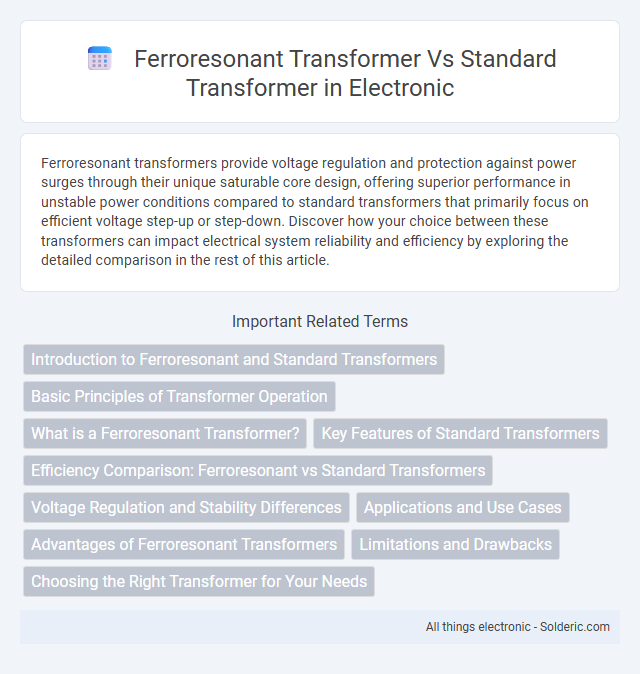Ferroresonant transformers provide voltage regulation and protection against power surges through their unique saturable core design, offering superior performance in unstable power conditions compared to standard transformers that primarily focus on efficient voltage step-up or step-down. Discover how your choice between these transformers can impact electrical system reliability and efficiency by exploring the detailed comparison in the rest of this article.
Comparison Table
| Feature | Ferroresonant Transformer | Standard Transformer |
|---|---|---|
| Voltage Regulation | Excellent voltage stabilization under varying loads | Voltage varies proportionally with load changes |
| Efficiency | Lower efficiency due to continuous core saturation | Higher efficiency with minimal core losses |
| Output Waveform | Possible waveform distortion due to saturation | Clean sinusoidal output waveform |
| Applications | Used in voltage regulation, industrial controls, and sensitive electronics | Power distribution, general electrical equipment |
| Size and Weight | Generally larger and heavier due to magnetic components | More compact and lighter |
| Cost | Higher initial cost and maintenance | Lower cost and easier to maintain |
| Noise | Produces audible humming due to core operation | Typically quieter operation |
Introduction to Ferroresonant and Standard Transformers
Ferroresonant transformers utilize a saturable reactor core designed to regulate voltage by maintaining a constant output despite input fluctuations, making them ideal for sensitive electronic equipment. Standard transformers operate on electromagnetic induction principles to transfer electrical energy between circuits without voltage regulation, commonly used for general power distribution. The ferroresonant transformer's ability to provide voltage stabilization and noiseless operation contrasts with the standard transformer's simplicity and efficiency in typical power applications.
Basic Principles of Transformer Operation
Ferroresonant transformers operate on the principle of magnetic saturation and resonance to regulate voltage, utilizing a nonlinear inductance and a capacitor to maintain a stable output despite input fluctuations. Standard transformers rely on electromagnetic induction between primary and secondary windings without inherent voltage regulation, transferring energy based on turns ratio and core magnetics. The ferroresonant design inherently limits voltage variations, while standard transformers require external devices for voltage stabilization.
What is a Ferroresonant Transformer?
A ferroresonant transformer, also known as a constant voltage transformer, uses a saturable reactor and capacitor to regulate voltage, ensuring stable output despite input fluctuations or load variations. Its design minimizes voltage spikes and provides inherent voltage regulation, making it ideal for sensitive electronic equipment and industrial applications. Unlike standard transformers, ferroresonant transformers maintain consistent voltage without the need for complex electronic controls or additional regulators.
Key Features of Standard Transformers
Standard transformers rely on electromagnetic induction and iron cores to efficiently transfer electrical energy at fixed frequency, offering consistent voltage regulation and high efficiency under varying loads. They typically feature laminated silicon steel cores to minimize hysteresis and eddy current losses, ensuring stable performance in power distribution systems. These transformers are commonly designed for standard AC frequencies of 50 or 60 Hz, providing reliable voltage transformation with minimal distortion in residential, commercial, and industrial applications.
Efficiency Comparison: Ferroresonant vs Standard Transformers
Ferroresonant transformers typically exhibit lower efficiency than standard transformers due to their inherent energy losses from magnetic saturation and continuous core excitation. Standard transformers generally achieve higher efficiency levels, often exceeding 95%, as they operate closer to optimal magnetic flux and minimal core losses. You should consider the efficiency trade-offs when selecting a transformer, especially if energy conservation is a priority for your application.
Voltage Regulation and Stability Differences
Ferroresonant transformers provide superior voltage regulation and stability by maintaining a nearly constant output voltage despite input voltage fluctuations or load changes, thanks to their inherent voltage stabilization through resonance. Standard transformers, however, exhibit more voltage variation under varying loads since they rely on linear magnetic properties without built-in voltage compensation. This makes ferroresonant transformers ideal for sensitive electronic equipment requiring stable voltage, while standard transformers are better suited for general power distribution with less stringent voltage regulation needs.
Applications and Use Cases
Ferroresonant transformers excel in applications requiring voltage regulation and surge protection, such as medical equipment, industrial controls, and communication systems, where maintaining a stable output despite input voltage fluctuations is critical. Standard transformers are widely used for general power distribution and voltage step-down or step-up in residential, commercial, and industrial environments where efficiency and cost-effectiveness are prioritized. Your choice depends on whether your application demands precise voltage regulation under variable loads or straightforward power transformation with minimal complexity.
Advantages of Ferroresonant Transformers
Ferroresonant transformers provide superior voltage regulation by maintaining a stable output voltage despite wide input voltage fluctuations, which is ideal for sensitive electronic equipment. Their inherent harmonic filtering capabilities reduce electrical noise and improve power quality, enhancing the performance and longevity of connected devices. You benefit from increased reliability and reduced maintenance costs due to their rugged design and ability to handle overloads without damage.
Limitations and Drawbacks
Ferroresonant transformers exhibit voltage regulation limitations under varying load conditions and generate audible noise due to saturation effects, making them less suitable for sensitive environments. They are bulkier and heavier compared to standard transformers, which can complicate installation and increase costs. Your choice should consider these drawbacks alongside the specific application requirements to ensure optimal performance.
Choosing the Right Transformer for Your Needs
Ferroresonant transformers provide superior voltage regulation and noise isolation, making them ideal for sensitive electronic equipment requiring consistent power quality. Standard transformers offer cost-effective solutions for general power distribution where precise voltage maintenance is less critical. Selecting the right transformer depends on balancing budget constraints with the necessity for stable voltage output and electromagnetic interference reduction.
ferroresonant transformer vs standard transformer Infographic

 solderic.com
solderic.com